Key takeaways:
- Hospital ministry provides emotional and spiritual support to patients and families, emphasizing the importance of presence and connection during vulnerable times.
- Grief manifests in diverse ways, with cultural backgrounds influencing mourning rituals and expressions of loss, highlighting the need for compassion and understanding.
- Personal grieving styles can be recognized through reflection, creative expression, and the influence of one’s environment, making self-awareness a crucial part of the healing process.
- Moving forward after loss involves integrating memories into life, engaging with communities, and allowing joy amidst sorrow, rather than viewing healing as a linear process.
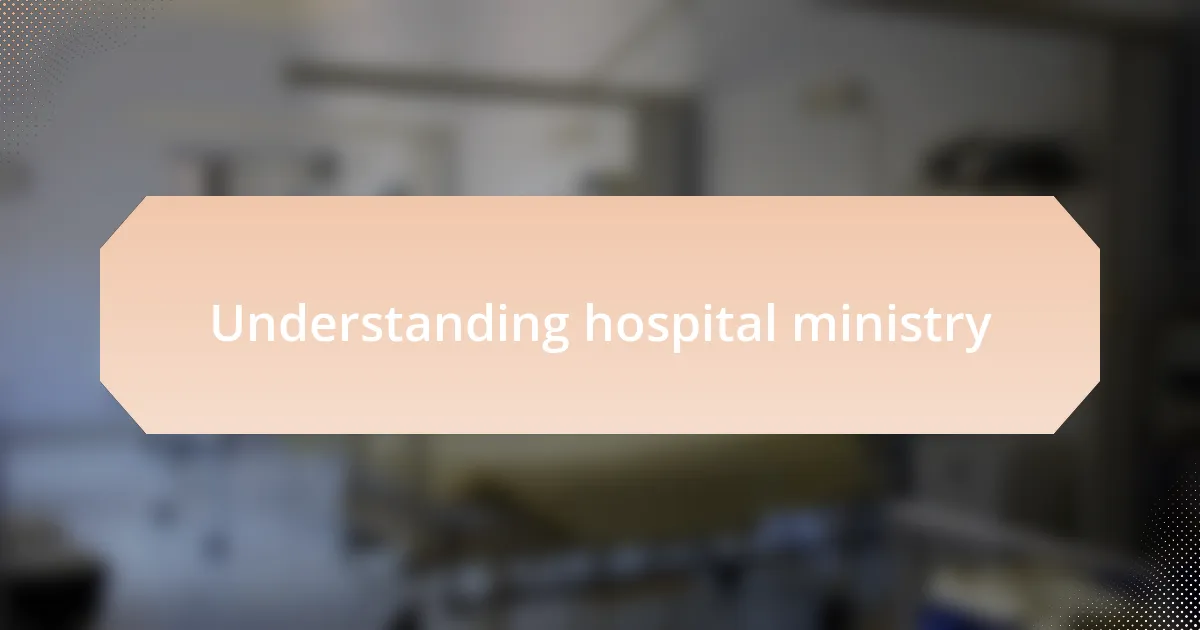
Understanding hospital ministry
Hospital ministry serves as a compassionate bridge between spirituality and healthcare, providing emotional and spiritual support to patients and their families during some of the most vulnerable times in their lives. I remember walking through the hospital halls myself, feeling a mix of anxiety and uncertainty. This experience made me realize how vital it is for someone to be there, offering a comforting presence and a listening ear.
In my experience, being part of hospital ministry means embracing the complex emotions that come with suffering and healing. Each visit presents a unique opportunity to connect with individuals facing pain and fear, and it often raises the question: how can we truly serve others when we sometimes struggle with our own grief? For me, the answer lies in sharing our authentic selves—acknowledging the shared humanity that fosters genuine connections.
I find that practical support, like offering prayer or simply being present, can be profoundly meaningful. Observing how families light up when offered a moment of understanding is heartwarming. It prompts reflection on the deeper purpose of hospital ministry—are we not all seeking solace in moments of distress? In fostering these connections, we become witnesses to both suffering and resilience.
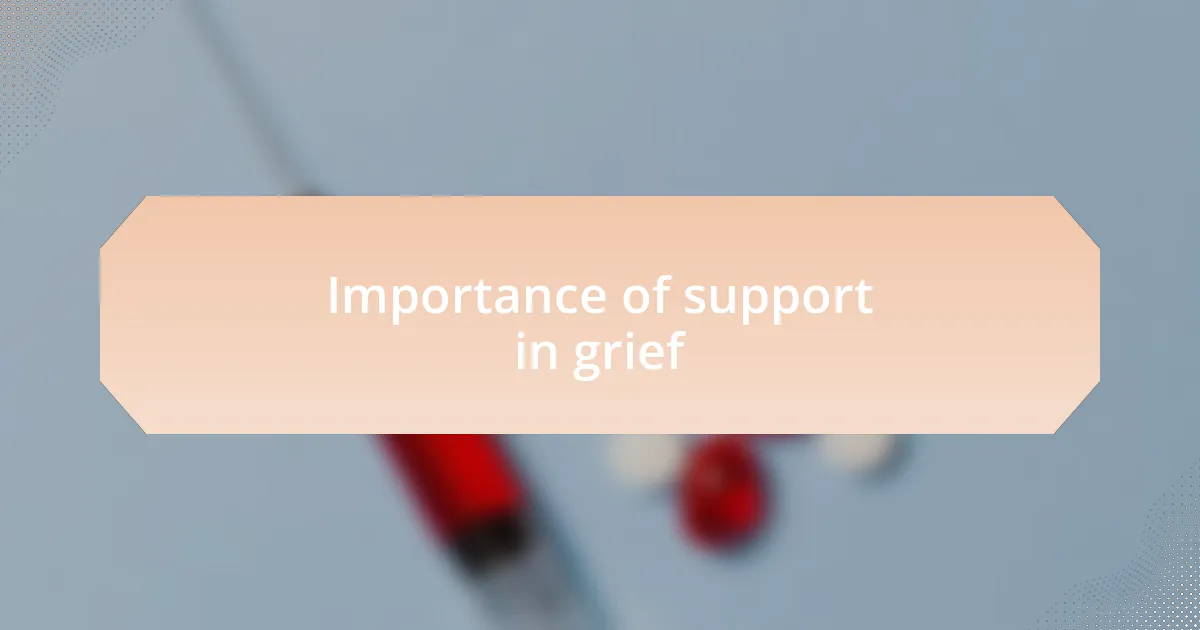
Importance of support in grief
Navigating grief can often feel like an isolating experience, and I’ve learned firsthand just how important support systems are during such times. I once encountered a family grappling with the loss of a loved one who found solace in sharing their memories with me. Their grief transformed into a collective expression, reminding me that even in sorrow, connections can help lift the weight of despair.
It’s fascinating how a simple gesture of support—a comforting touch, a heartfelt conversation, or a shared prayer—can create a safe space for those grieving. I observed a mother sitting quietly in a waiting room, her eyes filled with tears. When a fellow family member reached out to hold her hand, I noticed how their mutual embrace seemed to lighten her burden, if only for a moment. It’s moments like these that highlight the profound impact of being there for one another.
Supporters may not have the answers or solutions, but their presence often speaks volumes. It allows individuals to feel heard and validated, as if their pain matters. I often wonder how many people might find healing simply by knowing they are not alone. In my experience, offering that support can be one of the most powerful gifts we can give during someone’s time of loss.
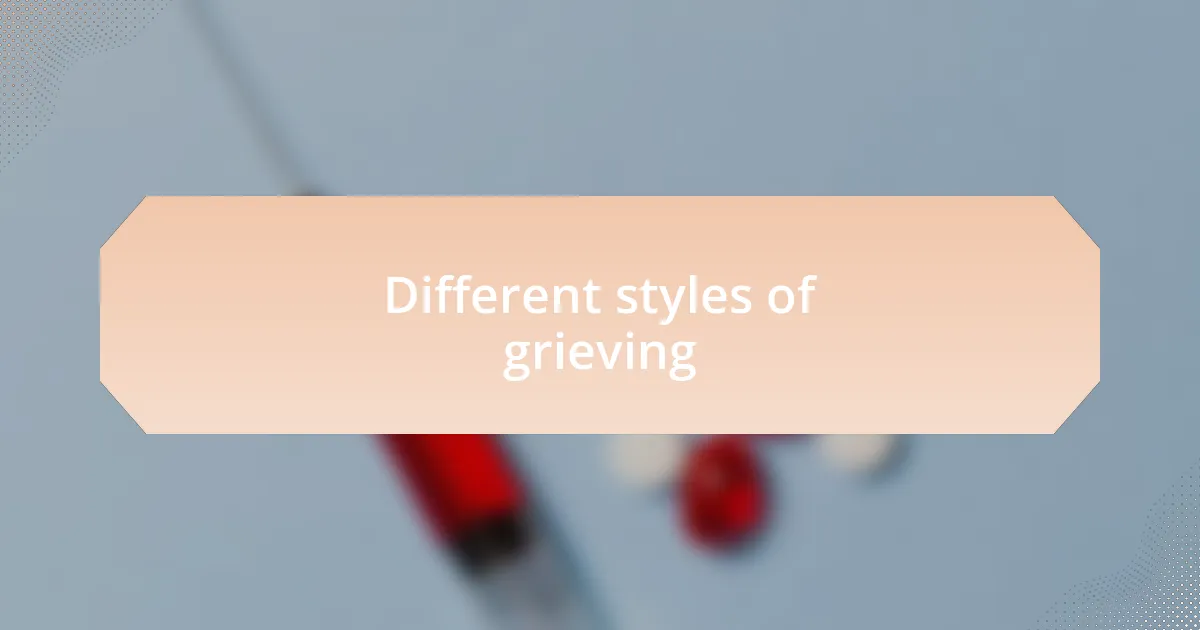
Different styles of grieving
Grief can manifest in various ways, and I’ve witnessed firsthand the diversity of grieving styles among those I’ve encountered. Some individuals prefer to express their sorrow openly, sharing their pain and memories aloud, while others retreat into solitude, processing their feelings in quiet reflection. I remember a client who chose to channel her grief into creative expression, filling notebooks with poetry that beautifully articulated her loss. Isn’t it intriguing how different avenues can provide solace?
I’ve also observed the phenomenon of “grief bursts,” where emotions seem to strike unexpectedly, catching individuals off guard. During a hospital visit, a husband suddenly broke into tears while discussing his late wife with her caregiver, illustrating that grief doesn’t follow a neat timeline. This experience made me realize that though some may appear composed on the surface, their internal world can be profoundly tumultuous. How do we prepare ourselves for those waves of emotion that can come crashing down at any moment?
Additionally, cultural backgrounds significantly shape how people grieve. In some cultures, communal mourning rituals bring friends and family together, providing a sense of collective healing. I attended a wake where storytelling was central to the grieving process, and it struck me how each shared memory became a thread tying everyone together in their shared loss. This rich tapestry of grief reminds me of the ways we can redefine our mourning by celebrating life alongside our pain. How do you navigate the intricate dance between remembering and grieving?
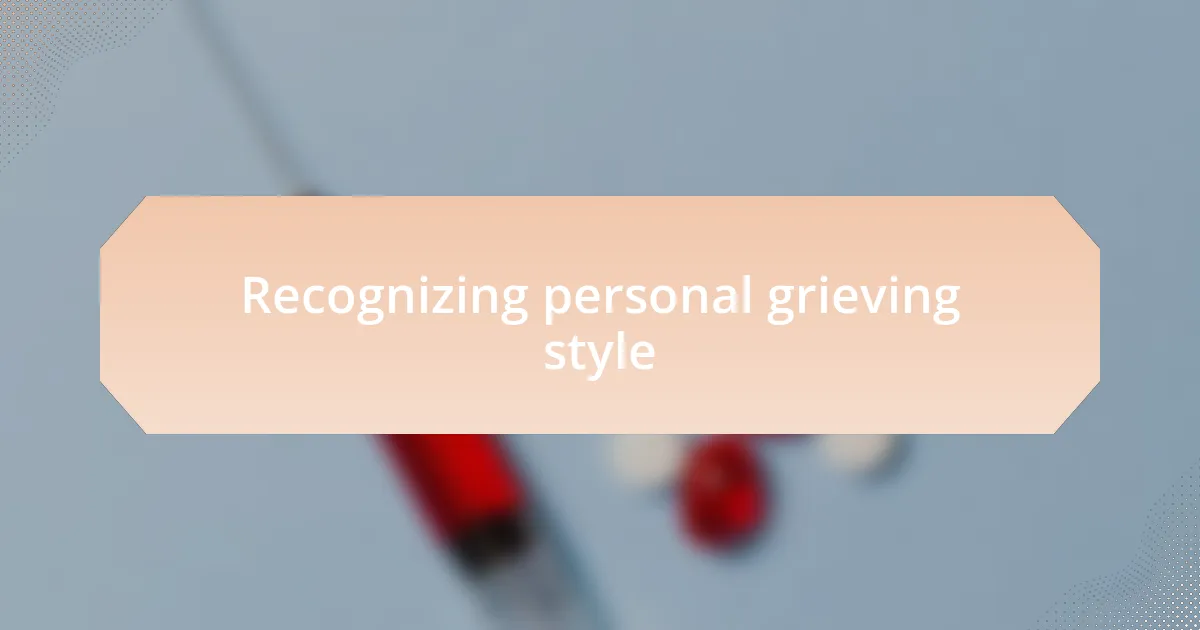
Recognizing personal grieving style
Recognizing how we each grieve is a profound journey. I remember my own experience when I lost a close friend; initially, I thought I’d be the strong one, but instead, I found myself playing my guitar late into the night, pouring my emotions into each chord. It was in those quiet moments of reflection that I realized my grief was deeply tied to my love for music. How does your unique creative outlet reveal your own grieving style?
It’s also striking to observe how our environment influences our grieving process. In one case, I encountered a woman who found solace in gardening after her mother passed away. Each bloom and budding flower became a symbol of her healing, a silent tribute to the love that still lived on in her heart. It begs the question: how do our surroundings shape our approach to loss and healing?
Recognizing personal grieving styles often requires intentional self-reflection. I recall journaling after my loss, allowing my thoughts to flow freely. Through that process, I discovered that articulating my feelings in writing helped me confront the full weight of my sorrow. What tools, I wonder, have you found effective in helping you navigate your own grief journey?
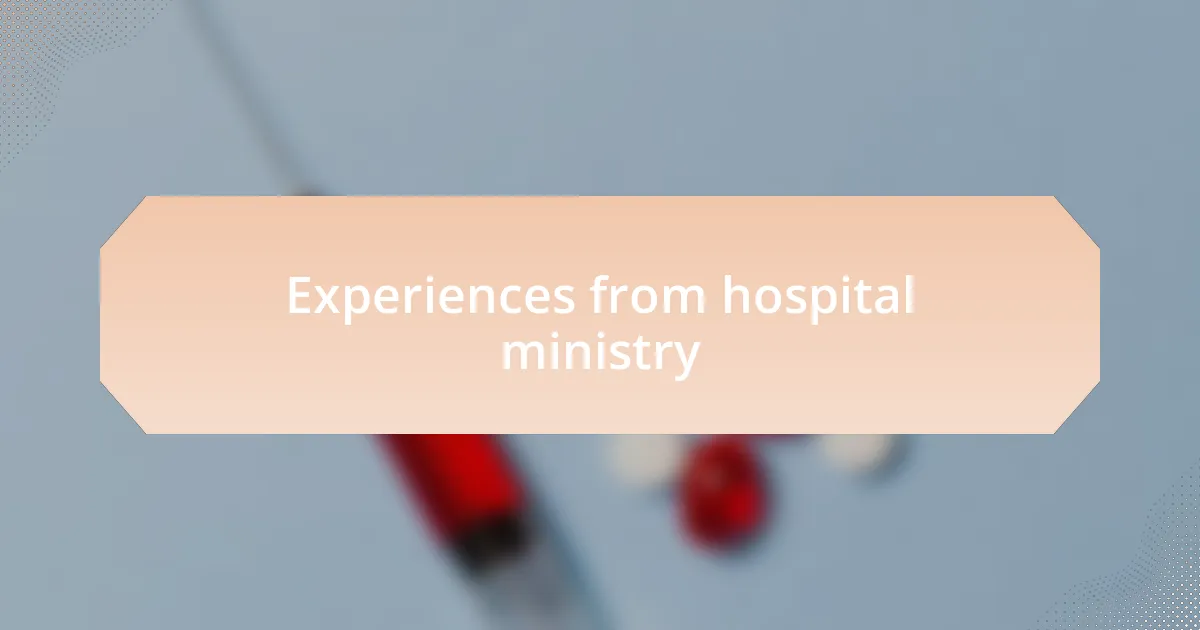
Experiences from hospital ministry
Engaging with patients and their families in a hospital ministry setting has profoundly shaped my understanding of grief. I recall an evening spent with a family who was saying their final goodbyes. Their shared laughter amidst tears opened my eyes to the complexity of grieving; it wasn’t just about sadness but also about celebrating the life that once was. How do we find the balance between sorrow and remembrance in these deeply emotional moments?
I’ve also seen the power of storytelling in the grieving process. One father shared memories of his late child, weaving tales filled with joy and laughter, despite the heavy heart he bore. This reminded me that sometimes, the act of remembering can be a healing balm. It leaves me wondering, how can our stories serve not just as a comfort to ourselves but as a guide for others navigating their pain?
Furthermore, I’ve learned that sometimes silence speaks the loudest in a hospital room. I often sit with patients, simply holding their hands, allowing them to feel my presence without the pressure of words. In those moments, I recognize how essential connection is during grief — it makes me reflect: In what ways can we communicate our support without saying a single word?
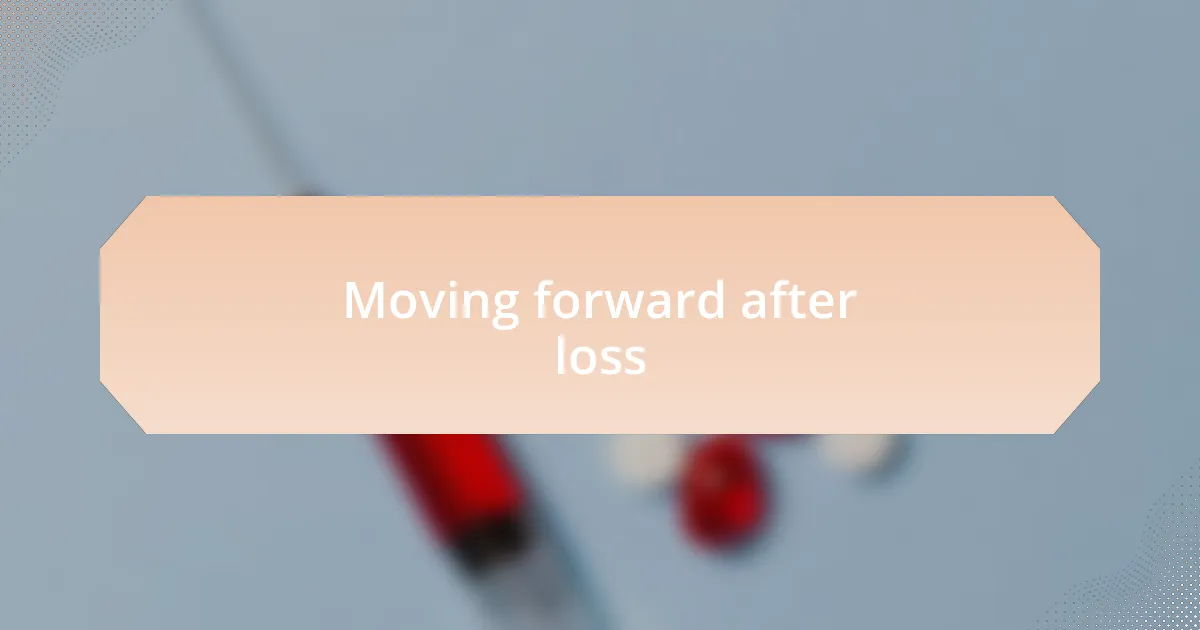
Moving forward after loss
As I moved through my journey of healing after loss, I discovered that progress can often feel nonlinear. I remember a day at the hospital when a patient’s family shared a comforting meal together, despite their sorrow. Their laughter mingled with tears, illustrating how moving forward sometimes means allowing joy, even in the midst of grief. It got me thinking: how do we give ourselves permission to smile while still honoring the pain?
In my experience, engaging with support groups can be transformative. There was one evening when I joined a circle of individuals navigating loss. Hearing their stories of resilience inspired me, as it highlighted that each person’s path to healing is unique. I realized then that moving forward requires not only acceptance of our feelings but also a willingness to share them with others. Could it be that our journeys become easier when we embrace community rather than solitude?
Sometimes, I find that simple rituals can help us connect with our memories and honor our loved ones. On the anniversary of a significant loss, I lit a candle while reflecting on cherished moments, creating a space for both grief and gratitude. It dawned on me that moving forward doesn’t mean forgetting; it’s about integrating those memories into our lives. How can we develop our own traditions that allow for both remembrance and renewal?